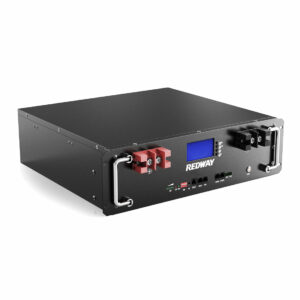What Are Server Rack Battery Backup Solutions?
Server rack battery backup solutions provide uninterrupted power via UPS integration, using LiFePO4 or lithium-ion batteries. Key features include 2-10kW runtime, modular scalability, and 45°C thermal tolerance. Always prioritize dual-grid redundancy and BMS monitoring to prevent downtime.
What Determines Telecom Battery Dimensions in Network Infrastructure?
What battery chemistries dominate server rack backups?
Modern systems use LiFePO4 (safety) or lithium-ion (energy density). LiFePO4 operates at 3.2V/cell with 5,000+ cycles, while lithium-ion delivers 3.6-3.7V/cell but requires strict thermal controls.

Beyond chemistry choices, server racks demand 48V DC systems for compatibility with telecom infrastructure. LiFePO4’s thermal runaway threshold of 270°C makes it ideal for dense deployments—compare this to lithium-ion’s 150°C limit. Pro tip: Deploy NMC variants if runtime trumps safety, like in edge data centers. For example, a 10kW rack using LiFePO4 can sustain 8 hours at 50% load, akin to a diesel generator’s mid-range performance. Transitional phases like partial outages benefit from lithium-ion’s faster recharge (1C rate vs LiFePO4’s 0.5C).
| Chemistry | Energy Density (Wh/kg) | Cycle Life |
|---|---|---|
| LiFePO4 | 90-120 | 3,000-5,000 |
| NMC | 150-200 | 1,000-2,000 |
How do UPS systems interface with rack batteries?
Server rack UPS units use double-conversion topology for clean power, synchronized via CAN bus or SNMP. Batteries connect through 30-150A busbars, supporting runtime from 5 minutes to 8 hours.
Practically speaking, the UPS’s rectifier stage converts AC to DC for charging, while the inverter handles outage transitions in <10ms. Advanced systems employ predictive load shedding—if a rack’s draw exceeds 80% capacity, non-critical servers shut down first. Consider a hospital data center: Redundant UPS units with N+1 configuration ensure MRI machines never flicker during grid fluctuations. Transitional technologies like Li-ion capacitors bridge milliseconds-long gaps, but aren’t substitutes for true battery backups.
What runtime factors matter for critical loads?
Runtime hinges on load wattage, battery capacity (kWh), and inverter efficiency (90-97%). A 5kW load with 10kWh batteries lasts ~2 hours at 95% efficiency.
But what if temperatures fluctuate? Heat reduces usable capacity—a 35°C environment cuts lithium-ion runtime by 15%. Always derate calculations by 20% buffer. For perspective, a cloud provider needing 4-hour runtime for 8kW loads would require a 40kWh battery bank, equivalent to eight Tesla Powerwall units. Transitional loads like SSD arrays (bursty 300W spikes) demand UPS units with 3:1 surge ratios.
| Load (kW) | Battery (kWh) | Runtime |
|---|---|---|
| 2 | 5 | 2.5h |
| 5 | 10 | 2h |
Why is modular design critical for scalability?
Modular racks allow hot-swap batteries and parallel expansion. A base 5kW unit can scale to 50kW via stackable trays, avoiding forklift upgrades.
Imagine a fintech startup: Starting with 10kWh, they add 10kWh increments as transaction volumes grow. Transitional phases between expansion require load balancing controllers to prevent single-battery overloads. Pro tip: Deploy standard 19″ racks to simplify third-party integrations. Ever notice how Lego blocks snap together? Modular batteries use similar blind-mate connectors for tool-free adds.
How do thermal management systems prevent failures?
Active cooling via ducted fans or liquid plates maintains cells at 20-30°C. LiFePO4 tolerates 45°C but degrades 2x faster above 40°C.
Beyond fans, some racks use phase-change materials (PCMs) absorbing heat during outages. Think of PCMs like ice packs—they buy 15-30 minutes until AC restores. Transitional strategies include variable-speed compressors that dial cooling based on SOC. A telco tower in Dubai might pair air-cooled racks with solar shades, slashing thermal stress by 40%.
What redundancy levels ensure 99.999% uptime?
2N+1 architectures duplicate every component plus a spare. For racks, this means dual BMS boards, A/B power feeds, and partitioned battery strings.
But isn’t this overkill? Not for Tier IV data centers. If one battery string fails, the second takes over within 5ms. Transitional redundancy uses load-sharing groups—three battery modules share a 10kW load, so one can fail without downtime. Like airplane engines, redundancy lets you “land safely” during critical failures.
FAQs
Can server racks use lead-acid batteries?
Yes, but AGM VRLA lasts only 3-5 years vs LiFePO4’s 10+. They’re bulkier—24V 100Ah AGM weighs 70kg vs 25kg for lithium.
How often should rack batteries be tested?
Run monthly discharge tests to 80% SOC. Automated BMS systems flag cells with >5% voltage deviation.
What Powers Cell Towers During Outages? Telecom Battery Essentials



